Gritty soil mix is simple to make with only a few ingredients, and works great for plants that like to stay dry. In this post, I’ll tell you all about what it is and the benefits. Then I’ll give you my recipe, and show you exactly how to make your own, step by step.
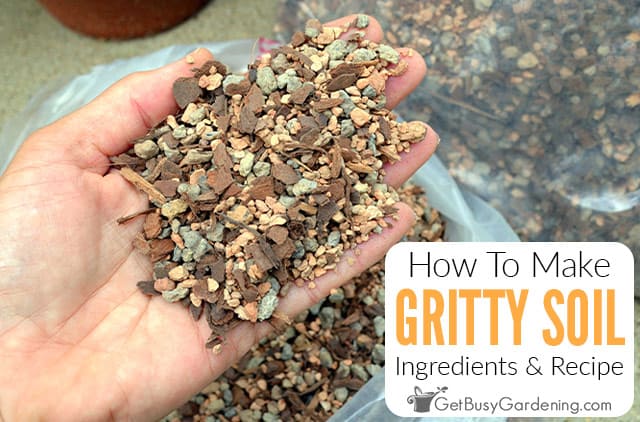
If you’re the type of person who tends to overwater plants, then switching to gritty soil will be a game changer for you!
With this super fast draining mix, you could water your plants every day without overdoing it.
Since it flows right through with minimal moisture retention, the roots will never be saturated, or stay wet for extended periods of time like they do in regular potting soil.
In this guide, I will tell you more about what it is, and give you all of the advantages. Then I’ll show you step by step how to easily make your own gritty soil mix with only a few simple ingredients.
What Is Gritty Mix Potting Soil?
Gritty mix is a soilless potting medium that is designed to drain very quickly. It’s made up of mostly non-organic materials, and ideal for plants that naturally thrive in arid climates, like succulents and cacti.
Benefits Of Gritty Soil Mix
The biggest benefit of a gritty soil mix is that it’s impossible to drown your plants, which is perfect for people who have a problem with overwatering.
But there are other great advantages too. It’s composition is similar to the ground in desert climates, where it doesn’t rain very often. So you can give it a really good, deep soaking, and then it dries out fast, just like in nature.
Since it’s made mostly of non-organic materials, it doesn’t break down quickly, or become compacted like regular potting soil can. So there’s no need to replace it, and you can reuse it over and over again.
It also allows for plenty of airflow between the particles, so the roots will never be smothered by compaction, or stay wet for too long.
Gritty Potting Mix Ingredients
For this gritty mix recipe, you’ll only need 3 ingredients: turface, granite, and pine bark. All of the pieces should be about the same size – and ideally be between 1/8 – 1/4″.
If they are smaller than that, the dust and fine particles will retain too much moisture, and can also end up blocking the drainage holes.
When they’re bigger, it can drain too quickly, or cause large air pockets around the roots, preventing them from absorbing any moisture.
Below I will discuss each ingredient in detail, and give you some substitutes in case you can’t find them where you live.
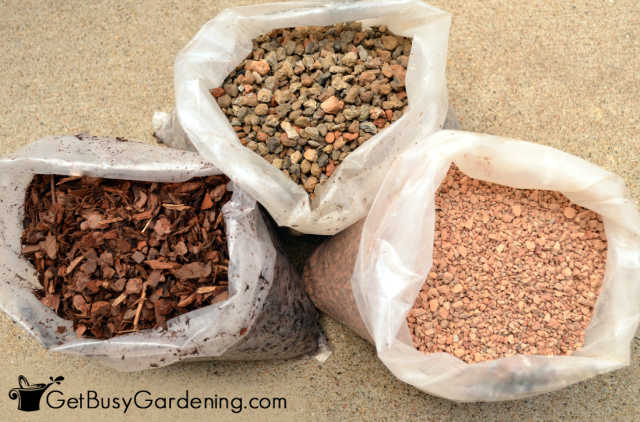
Turface
Turface is a type of clay that looks like tiny bits of terracotta. It has good drainage, but also helps hold moisture a bit longer. So your gritty potting mix will drain fast, but won’t become bone dry right away, which is exactly what we want.
If you can’t find turface where you live, the best alternative is calcined clay. You could also try experimenting with pumice or perlite instead, but full disclosure, I have not personally tried those in this recipe.
Granite
Granite doesn’t hold moisture at all, and will allow the water to pass right over it. This keeps it from pooling, and helps the gritty soil mixture dry faster.
You could substitue chicken (poultry) grit, since that is commonly made out of granite. However, keep in mind that you will likely have to sift it yourself to get the right size.
Pine Bark
Pine Bark also helps to retain moisture, but not as long as other similar substrates. Though it is an organic material, it takes a very long time to break down, so it won’t become compacted.
You could use fir or orchid bark instead, but the chunks in many of these products are much larger than the 1/8 – 1/4″ inch size we need here.
Gritty Mix Soil Recipe
Supplies Needed:
- Measuring container
- Trowel or shovel
- Bucket or table top try (or another container for mixing)
- Dust mask
- Sifting screens (only if your ingredients aren’t pre-sifted)
How To Make Gritty Soil
Before getting started, make sure to wear a dust mask, especially if you’re going to be sifting the ingredients yourself. It’s not good to breath in those tiny particles.
Also note that the products I recommend and have linked to in the supplies list above are pre-sifted to the 1/8″ to 1/4″ size. So if you buy those or something similar, then you can skip step 1.
Step 1 (optional): Sift the particles – If your materials are not pre-sifted, then you need to do this first. Use your sifting screens to filter out anything smaller than 1/8″. Then do again using a larger screen to get rid of the pieces bigger than 1/4″.
Don’t worry, you can save the smaller and larger pieces for other potting soil recipes, so they won’t go to waste.
Step 2: Measure your ingredients – Use your measuring container to portion out equal parts of the pine bark, granite, and turface.
You can use anything you want for this. For example, a one cup measure, a bowl, scoop, or bucket… it doesn’t matter. Just use the same thing for all three ingredients so you have equal parts of each.
Step 3: Mix it all together – Now all you need to do is stir everything together using your trowel or shovel. I like to do this in my table-top potting tray, but you could use a bucket or wheelbarrow instead, if that’s what you prefer.
Whatever you use, make sure all of the ingredients are mixed together really well so they are distributed evenly throughout the mix.
Related Post: How To Make Your Own Cactus Soil Mix (With Recipe!)
Step 4: Use it right away – There’s no need to wait, you can use your gritty mix right away. One thing to keep in mind is that, since it is so porous, it won’t compact around the roots like regular potting soil does.
So your plant may be a bit wobbly, and small ones may need a little extra support until the roots become established, which is totally normal.
Though making your own is really easy, if you don’t want to bother with it, you can buy it all premixed and ready to go here.
Storing The Leftovers
If you end up making more than you need, you can store it for later. Simply put it into a bucket with an air-tight lid, and keep it in a cool, dry location until you need it again.
Storing it is also a good option if you want to make a big batch so you always have some on hand when you need it. Just make sure to use a sealed container so your gritty soil doesn’t become contaminated while in storage.
FAQs
In this section, I’ll answer some of the most frequently asked questions about gritty soil. If you can’t find your answer here, ask in the comments below.
How do you use gritty mix?
You can use gritty mix for any type of plant that needs good drainage, like succulents and cacti, for example. You could also use it as a decorative soil cover on any type of plant.
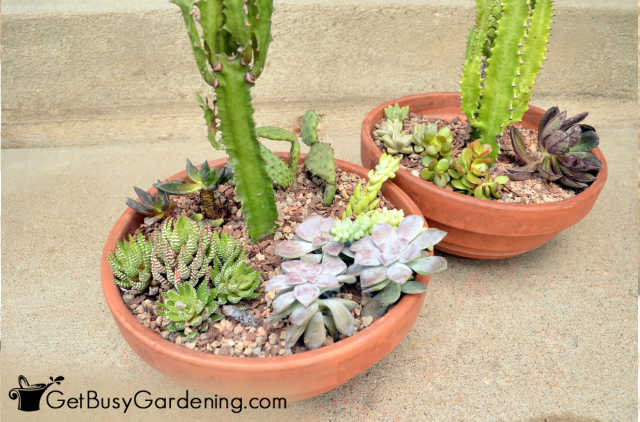
What is gritty mix made of?
Gritty mix is made of porous ingredients that allow the water to run through, and does not retain moisture very long. Examples include turface, granite, grit, pumice, and pine bark.
How often do you water gritty mix?
How often you water gritty mix depends on your habits and preference. Since it drains very quickly and doesn’t hold onto moisture for long, you’ll need to water more often than you’re used to.
As long as it’s made correctly, you could water gritty mix potting soil every day without worrying about overdoing it. But if you find that it dries out too quickly for your liking, then I recommend trying my succulent soil recipe instead.
Gritty mix is easy to make, and you only need a few ingredients. This recipe is perfect for plants that like to stay dry. Simply follow the steps above, and you’ll be all set. Or you could customize my recipe to suit your needs, and the needs of your plants.
More About Garden Soils
- How To Choose The Best Jade Plant Soil
- No Dig Gardening 101: How To Start A No Till Garden
- How To Choose The Best Money Tree Soil
Share your favorite recipe or your tips for making gritty soil in the comments section below.
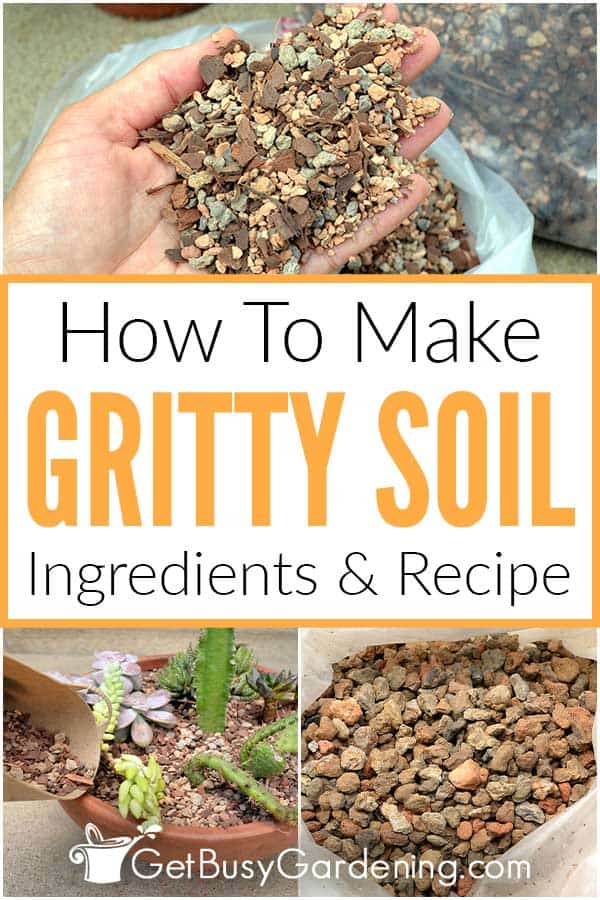
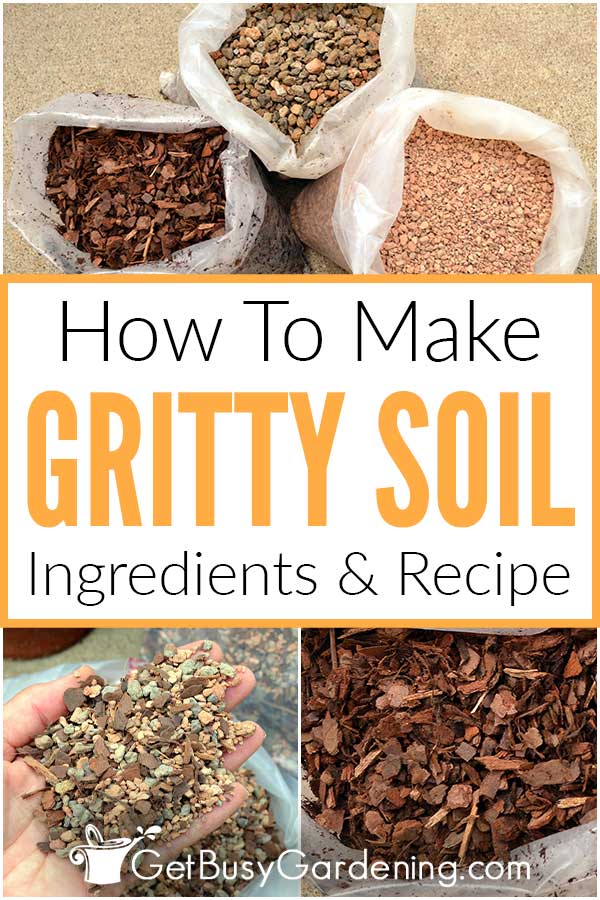
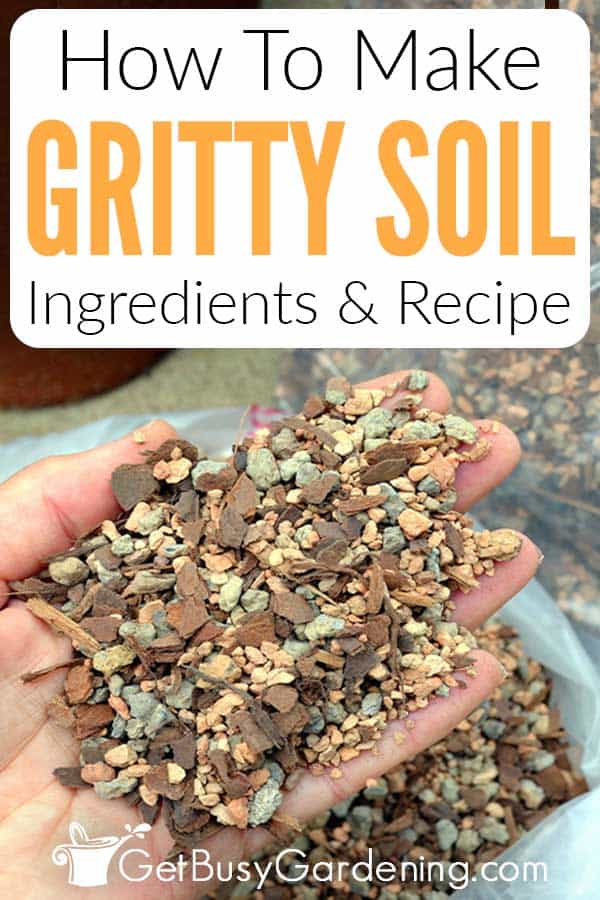

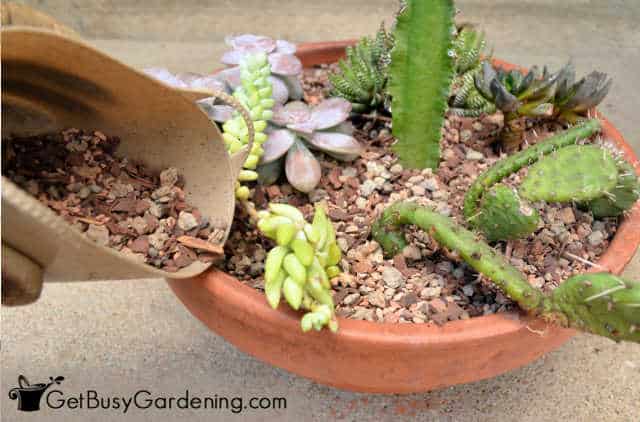
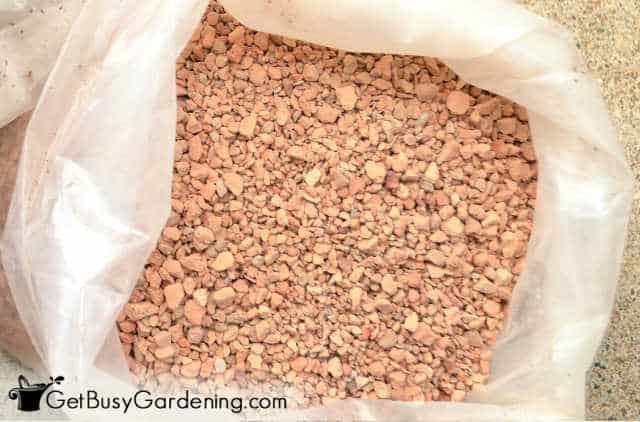

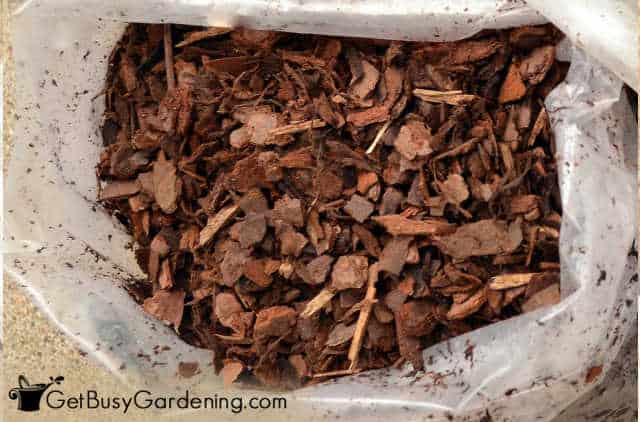
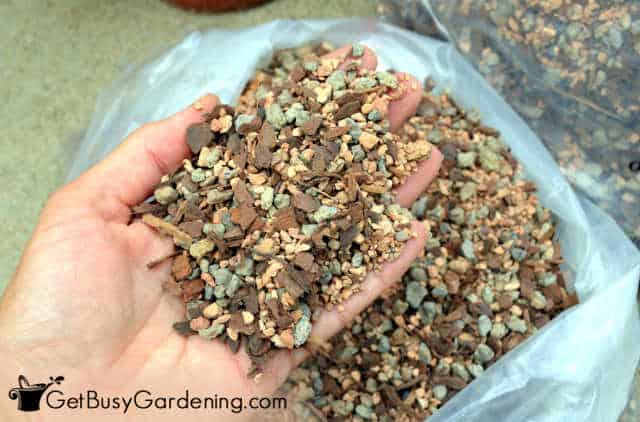

Alice says
Have you ever tried orchids with gritty mix? I transplanted mine into big box purchased orchid potting soil and i think it is way too soil based, tending towards over-retention of water. Orchid roots tend to rot with the slightest bit of overwatering, so I was wondering if you have any experience or knowledge of using gritty mix for orchids.
Amy Andrychowicz says
While this gritty mix could work just fine for orchids, I would recommend getting a medium specifically made for them. Typically those are made from pine bark or larger chips, or sphagnum moss as the main ingredient.
Dympna Curran says
Can I use any kind of bark in making compost for my succulent. Thank you dympna
Amy Andrychowicz says
Only use bark that is specifically made to used as a soil additive, I use pine bark.
Rachel says
Will a mixture of volcanic rock, pumice, granite & coarse sand work for gritty mixes?
Amy Andrychowicz says
I have never tried that combination for my gritty mix, so I can’t say for sure. I personally prefer to have some kind of organic matter in there for a tiny bit of added nutrients and moisture retention, that’s what the pine bark is for. I don’t think you would need all three of the volcanic rock, pumice, and coarse sand personally, because they are quite similar. But you could certainly experiment with it to create a mix that works best for you.
Jen says
Hi- can I use bonsai jacks with itty bitty seedlings, and if so should I layer a small amount of sand on top so the seeds don’t fall through?
And when they are just itty bitty seeds on top of this mix, how do you know when to water? Thank you_ I have been unsuccessful at germinating so far. I can’t find a complete step by step how to sow and germinate including how and when to water anywhere 🙁
Amy Andrychowicz says
This gritty mix wouldn’t be ideal for planting seeds or tiny seedlings. Like you said, they would probably just get lost in there. Try using my DIY succulent soil mix instead, that would work much better for them. As for watering, it would be best to plant them in tiny pots or seed trays, then water them from the bottom to allow the soil to soak it up, rather than pouring it over the top. Here’s a post that’s all about the basics of how to grow seeds.
kiara says
I am new to growing succulents from seeds. I am wondering if i can use my promix cactus soil to start seeds or do i have to add coarse sand to it as well?
Amy Andrychowicz says
I would try it with the commercial cactus soil first. If it holds too much water, then you should add in some coarse sand for the next batch.
Kiara Pepe says
Thank you so much!!
Nancy Grove says
Hi Amy,
I have started working with succulents. My look really bad so I ordered some of this gritty succulent soil mix. I have started transplanting my plants in that. My question is how do they ever hold any of the water. As soon as I put water on it runs straight through. Is this normal? If this is okay then how do I know how often to water them?
Thank you,
Nancy
Amy Andrychowicz says
Yes, that’s how this gritty soil works. Succulents don’t like a lot of water, and will only rot if the soil stays too wet. The beauty of this mix is that it makes it harder to overwater. I would recommend watering them every week during the summer, and maybe once every 2-3 weeks during the winter. If they are drying or shriveling too quickly, then water them more often.
Nancy says
Thanks. That’s a big help.
Daly says
I have some succulents I keep indoors in glass jars with gritty mix. I’ve noticed the gritty mix gets a fair amount of mold growing on it. This doesn’t seem to bother some of my succulents, but I think it’s led to others rotting. Do you have any recommendations for dealing with the mold?
Amy Andrychowicz says
If there aren’t drainage holes in the bottom of the containers, then that is why mold is growing on the gritty mix. Overwatering is also the reason some of your succulents are rotting. I recommend repotting them into containers that have drainage holes, still using the gritty mix for them.
Daly says
Thanks for your reply!
Amy Andrychowicz says
You bet!
Sandy says
Can you fill a planter with using just sand to grow succulents if there is no drainage holes in bottom?
Amy Andrychowicz says
I would not recommend using a pot that doesn’t have drainage holes for succulents. It’s very easy to overwater them if there aren’t drainage holes, and using sand alone isn’t going to help much. You can always drill holes in the bottom of the container. Or use a container that has holes in the bottom, and drop it into the decorative cache pot. That way, you can pull it out when you water, allow the excess to drain out, then pop it back into the decorative pot. I do this with a lot of my plants.
Claire says
I tried this mix because multiple blogs raved about it. The only succulents it hasn’t killed, or started to, are my cactus, a tiger tooth aloe and a Bears paw. I have two bear paws actually, One in cactus soil amended with extra sand and perlite and the other in bonsai Jack gritty mix. The one in soil is flourishing, even in the winter! (Indoor under grow lights) The other is definitely pretty stagnant. I had a beautiful ghost plant and an Echeveria that apparently hated it. I’m so bummed. Stuff wasn’t cheap either. I’m sure it’s great for some and maybe not for others but I don’t know how to distinguish which ones would do best in all Gritty vs another mix.
Amy Andrychowicz says
Oh bummer, sorry to hear the mix hasn’t worked out for you. I have found that you do need to water a bit more often when using this gritty mix vs a soil mix. Maybe that’s the problem with yours? All of the succulents I planted in this gritty mix grew wonderfully. But if the other mix works better for you, then stick with I’d that. 🙂
Shirley Crider says
I just repotted several pots with The Bonsai Jack succulent mix. I would like to know how you know when to water since the soil is so gritty it is hard to tell.
Amy Andrychowicz says
Succulent plants start to soften up a bit when they need more water. So, one sure way to tell is to gently squeeze the leaves every few weeks. If the leaves are firm, then they’re good to go. Once they start to soften up, then it’s time to water them.
Sophia says
I heard somewhere that you have to use plant food with gritty soil mix since there aren’t any nutrients in it like with regular potting soil. Is this true or can I just use the bonsai jack gritty mix with my succulents and water them with plain water? Also, I just repotted some of my succulents and cacti with the bonsai jack gritty mix I got off amazon, and I found it hard to plant them and get the roots into the mix because it wasn’t as “squishy” and moldable as moist potting soil. Any advice on how to get the plants deeper into the mix? I am pretty sure all the roots are covered by the mix but I’m nervous they aren’t deep down enough, if you get what I mean haha I don’t know if I explained that right..
Amy Andrychowicz says
Succulent plants aren’t heavy feeders, and really don’t need to be fertilized. Of course, just like any other plant, they will benefit from being fertilized. But they thrive in gritty, non-organic soil. But you can use a water-soluble plant food with this mix just like you normally would. I know what you mean about the soil being different, LOL! If the roots are covered, and the plants are standing up fine on their own, then I think you’re good to go. Otherwise, if they are loose, then you can stake them until the roots become established.
Sophia says
Thank you for your response!
Amy Andrychowicz says
You’re welcome!
John says
I use small gravel in the bottom of the pot to keep the soil from packing and plugging the drain hole. I put about an inch or two depending on the size of the pot. It works great and lets the excess water drain more easily. I do that with succulents and ordinary flowering plants. Just make sure the gravel is clean so you don’t introduce any nasties into the mix.
Crossing says
This is probably silly. The gritty mix is expensive, do you recommend something else to fill the bottom of the planter and then the gritty mix where the plants are?
Amy Andrychowicz says
Succulent plants have pretty shallow roots, so you could use smaller containers. Otherwise, check out my DIY succulent soil recipe to see if you prefer that one… DIY Succulent Potting Soil Recipe.
Mose says
I like using shipping peanuts as a filler under my soil mixes. It is super cheap, doesn’t break down and takes up unused space that would otherwise waste expensive products.
Tamara says
I’m just starting out & have ordered some mixed succulent cuttings from Amazon. Can I use the Bonsai Jacks mix to grow these or should they start off in something more wet?
Amy Andrychowicz says
Sure, you can use a gritty mix for any succulents. I hope your new babies will grow well for you! 🙂
Michele says
This may be a dumb question but do I mix anything with Bonsai Jacks mix or just use it alone?
Amy Andrychowicz says
You can use the Bonsai Jack mix alone, no need to mix anything with it. 🙂